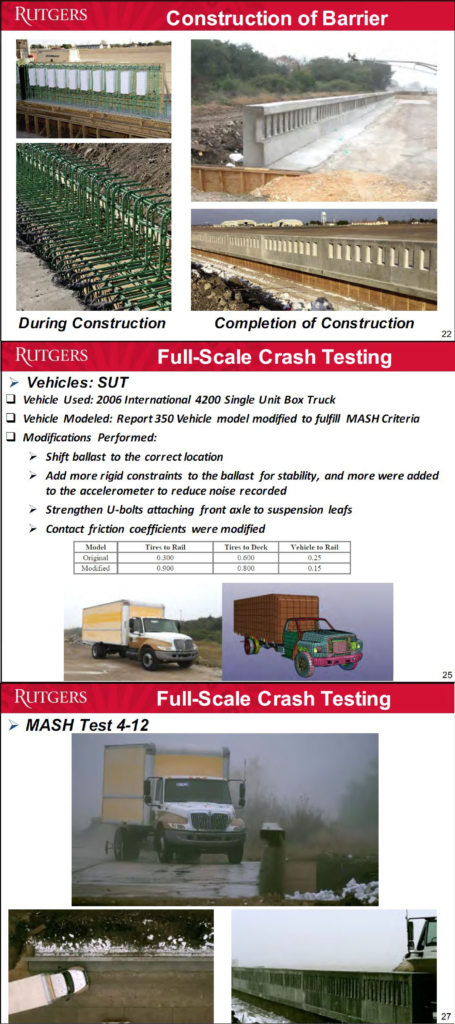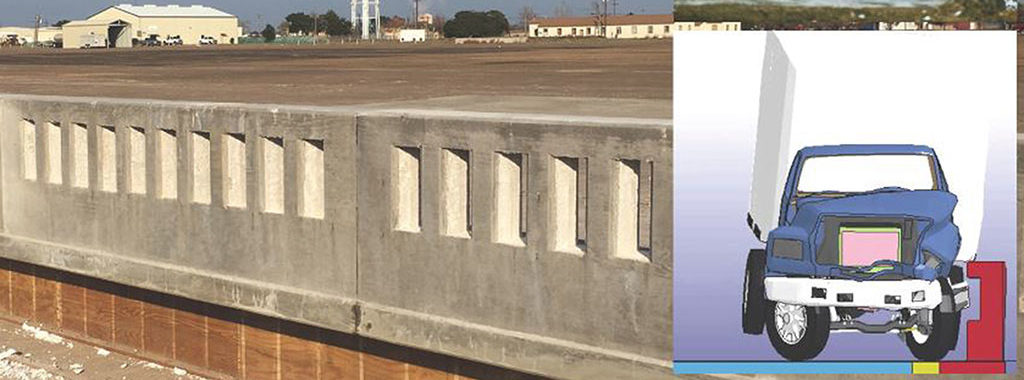 Recently, the Rutgers Infrastructure Monitoring and Evaluation (RIME) Group, a multi-modal transportation infrastructure research and education facility, was tasked to develop an open-faced concrete balustrade design that meets the aesthetic requirements of the Historic Preservation Office (HPO) and the safety requirements of FHWA. The RIME research team used computer simulation—detailed finite element analysis via LS-DYNA—and full-scale crash testing according to MASH TL-4 safety performance criteria. The result was a historical and crash-tested parapet for the Pulaski Skyway that can be used to replace similar barriers nation-wide while maintaining safety and retaining its aesthetic shape.
Recently, the Rutgers Infrastructure Monitoring and Evaluation (RIME) Group, a multi-modal transportation infrastructure research and education facility, was tasked to develop an open-faced concrete balustrade design that meets the aesthetic requirements of the Historic Preservation Office (HPO) and the safety requirements of FHWA. The RIME research team used computer simulation—detailed finite element analysis via LS-DYNA—and full-scale crash testing according to MASH TL-4 safety performance criteria. The result was a historical and crash-tested parapet for the Pulaski Skyway that can be used to replace similar barriers nation-wide while maintaining safety and retaining its aesthetic shape.
Dr. Hani Nassif, Professor of Civil and Environmental Engineering at Rutgers University and the lead Principal Investigator, spoke about the project at NJDOT’s Bureau of Research Lunch Session, on Monday, July 17. His talk, which is part of an ongoing Tech Talk series, gave an overview of the design, modeling and crash testing of open-faced concrete barriers, a study which started three years ago, spurred by a 2011 change in AASHTO requirements adopted by FHWA. This was the first completed study with these new requirements, partly due to cost—it costs a minimum of $250,000 to complete each crash test—and partly because the HPO was reluctant to replace parts of the Pulaski Skyway until recently preferring to preserve and redesign the current balustrade.
The study had a significant modeling component conducted using the LS-DYNA simulation program, a program that analyzes the nonlinear response of structures. Next, RIME did a parametric study before the physical testing began. The function of the new barrier is to bring the truck back into the lane, so the physical tests had a box truck, pickup truck, and sedan hit the barrier joints specifically, but at different angles. In all three instances, the vehicles were controlled and redirected back into traffic.
The result was that the testing was successful and met MASH requirements and the new barrier is in queue for approval by the FHWA. Other conclusions from the study are that dynamic finite element modeling is a good tool, and a computer simulation validated with full-scale test data can replace a full-scale test. Dr. Nassif noted that one future task is to design a guardrail transition terminal, checking the barrier with MASH TL5 using LS DYNA Model and then crash test if the models provide acceptable results.
The Lunchtime event, the second installment of the Tech Talk series, was well-attended with about 40 NJDOT and industry professionals. For those present, the event provided opportunities for back and forth Q&A, including a discussion about damage to the infrastructure based on the test barrier specifications. One attendee commented that he was looking forward to follow-up on the project regarding FHWA’s response.
The Rutgers Infrastructure Monitoring and Evaluation (RIME) Group is a multi-modal transportation infrastructure research and education facility that focuses on structural health monitoring, advanced concrete materials, finite element analysis, traffic and transportation analysis, and life cycle cost analysis.
The Project Team included:
Lead PI: Hani Nassif, Ph.D., Rutgers University
Co-PIs: Malcolm Ray, PE, Ph.D., Chuck Plaxico, Ph.D., Roadsafe LLC
Research Affiliates: Andrew Wassef, Dan Su, Ph.D., Chaekuk Na, Ph.D.
Giri Venkiteela served as NJDOT Project Manager
Resources
Nassif, H. (2017). More than a Pretty Face(ade): Meeting Safety & Historic Requirements in Concrete Barriers (Presentation).

